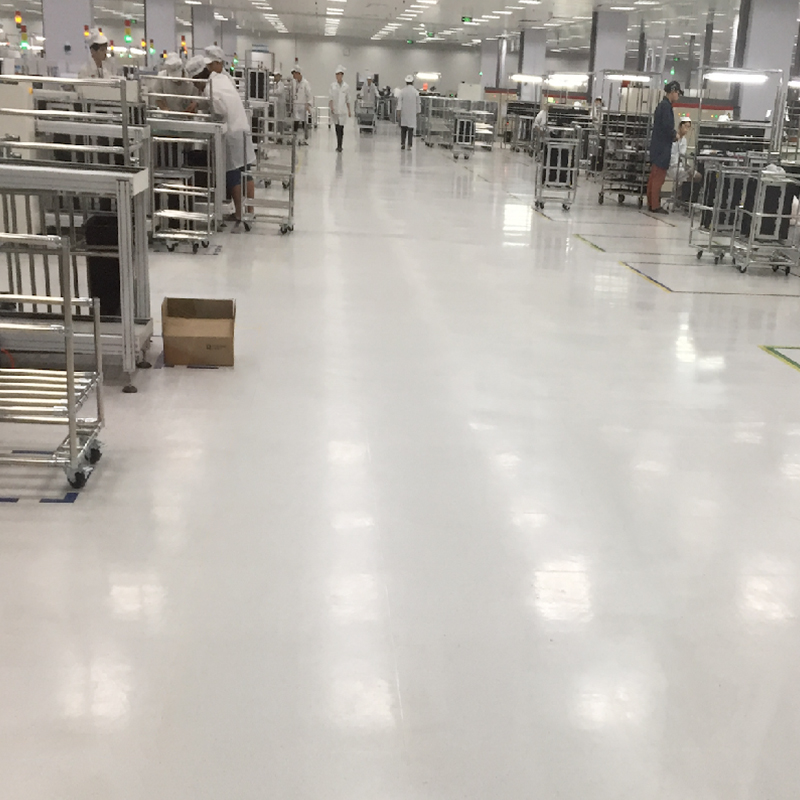Blog
In the food production industry, food safety is of paramount importance, and the hygiene of the production environment directly affects the quality and safety of food. For food workshops, laying homogeneous flooring on the ground is a common choice. However, how to prevent bacterial growth at the edges of the flooring has become a key issue in ensuring workshop hygiene. The answer is to extend the flooring 10cm up the wall, creating a seamless connection between the floor and the wall, eliminating the gaps where bacteria can thrive at the source.
As the core area for food production, food workshops must adhere to strict hygiene standards. The floor not only has to withstand frequent cleaning and disinfection, equipment handling, and pedestrian traffic but also resist the erosion of substances such as oil stains, acids, and alkalis that may be generated during food processing. During use, traditional floor materials are prone to cracks and wear. These gaps and damaged areas become breeding grounds for bacteria, posing a potential threat to food safety. Although laying homogeneous flooring has characteristics such as wear resistance and stain resistance, if the connection between the flooring and the wall is not properly handled, the edge gaps will still become a "hotspot" for bacterial growth.
Extending the homogeneous flooring 10cm up the wall to create a seamless connection between the floor and the wall is based on a scientific antibacterial principle. At the junction of ordinary floors and walls, due to the presence of gaps, thorough cleaning is difficult. Moisture and dirt easily accumulate in these areas, and the suitable temperature, humidity, and nutrient conditions provide an ideal living environment for bacteria. After extending the flooring 10cm up the wall, the gaps between the floor and the wall are eliminated, forming a continuous and smooth surface. Whether it is daily cleaning or deep disinfection, cleaning tools can operate unobstructed, leaving no place for stains to hide, and thus bacteria lose the space to grow.
From the perspective of practical application effects, this seamless connection significantly improves the cleaning efficiency of food workshops. Workers do not need to spend a lot of time and effort dealing with hard-to-reach corners, reducing cleaning dead zones and enabling more efficient completion of workshop cleaning tasks. At the same time, the seamless floor-wall structure also reduces the risk of damage caused by cleaning tools colliding with the gaps during the cleaning process, extending the service life of the homogeneous flooring and reducing the maintenance costs of the workshop.

In addition to effectively preventing bacterial growth, the seamless connection design of extending the flooring 10cm up the wall brings many additional advantages. In terms of aesthetics, this design makes the overall environment of the food workshop cleaner and more unified, enhancing the visual effect of the workshop and meeting the high requirements of modern food production enterprises for the workshop environment. In terms of functionality, it enhances the protective performance of the floor and wall, better resisting situations such as liquid leakage and stain splashing that may occur during food processing, protecting the building structure of the workshop from erosion, and maintaining a good production environment in the workshop.
Although the seamless connection design of extending the flooring 10cm up the wall can effectively prevent bacterial growth, in actual application, it still needs to be combined with correct cleaning and disinfection procedures and daily maintenance management. Regularly clean the floor and wall with professional cleaning agents and disinfectants, and avoid using overly sharp or rough cleaning tools to prevent damage to the floor surface. At the same time, based on the actual layout and production requirements of the workshop, reasonably plan the drainage system to ensure that there is no water accumulation on the floor, further reducing the possibility of bacterial growth.
In conclusion, when laying homogeneous flooring in food workshops, extending the flooring 10cm up the wall to achieve a seamless connection is an effective measure to prevent bacterial growth at the edges. This design fundamentally solves the hygiene hazards at the junction of traditional floors and walls. Combined with scientific cleaning and maintenance management, it can create a safe, hygienic, and efficient workshop environment for food production, firmly building a solid defense line for food safety.
Add : No.5 Huaqing Intelligent Park, Huishan District, Wuxi, Jiangsu, China
Copyright © 2025 WUXI TEFA DECORATION MATERIAL CO., LTD. All Rights Reserved.
Sitemap | Blog | Xml | Privacy Policy
 Network Supported
Network Supported